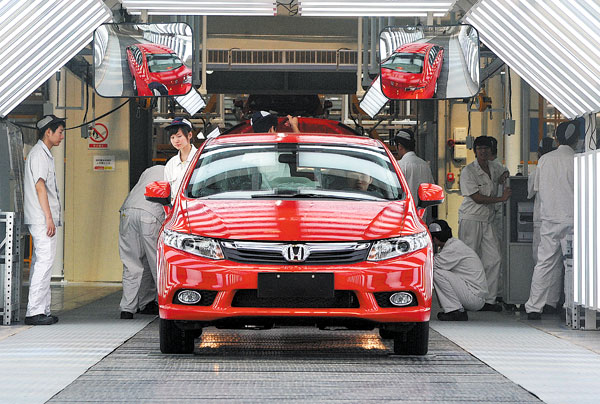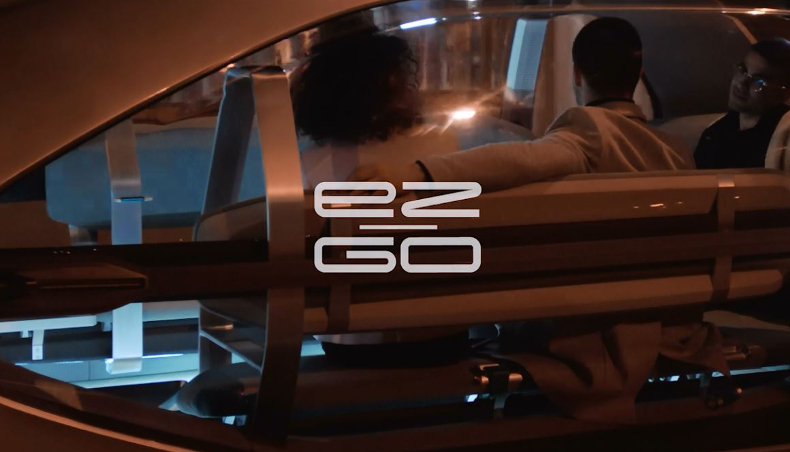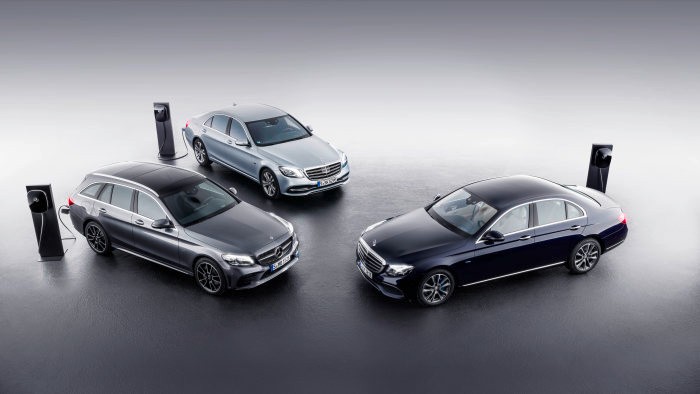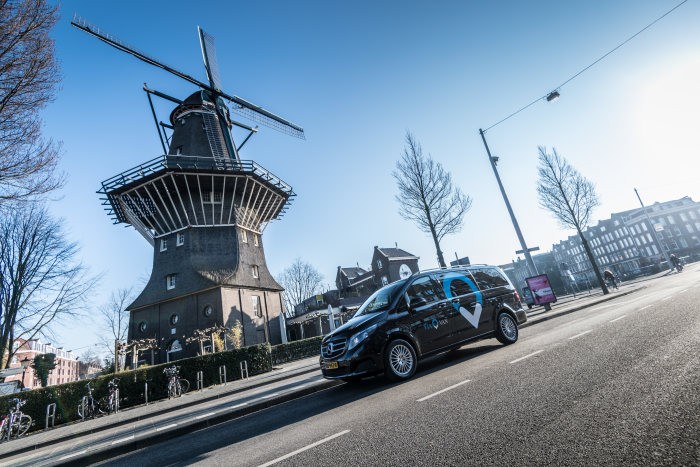Category: News Type
SF Motors Pushes Forward on its Autonomous Ambitions, Deploying Advanced Research and Test Vehicles Across Silicon Valley
SANTA CLARA, Calif., March 5, 2018 /PRNewswire/ — SF Motors announced it has begun test driving autonomous technology on the streets of Silicon Valley after receiving a permit from California’s Department of Motor Vehicles to test autonomous vehicle technology on public roads. With two manufacturing plants and four R&D offices across three continents, SF Motors is… Continue reading SF Motors Pushes Forward on its Autonomous Ambitions, Deploying Advanced Research and Test Vehicles Across Silicon Valley
Dongfeng Honda pauses deliveries
Workers check cars at a Dongfeng Honda production line in Wuhan, Hubei province. [Photo provided to China Daily] Suspension comes amid reported problems with lubricant levels in CR-V and Civic models, Hao Yan reports. Dongfeng Honda Automobile late last week acted to immediately halt deliveries of its turbocharged 2018 CR-V and Civic models, in the… Continue reading Dongfeng Honda pauses deliveries
Meet Renault EZ-GO, our new concept
Monday 05 March 2018 by Caroline De Beaumont – Innovation Caroline De Beaumont Share on Twitter Share on Facebook Share on LinkedIn Share on Pinterest At Geneva International Motor Show, Groupe Renault will unveil its vision of shared urban mobility; driverless, electric and connected. After introducing last year its vision of personal owned mobility with… Continue reading Meet Renault EZ-GO, our new concept
EQ Power: launch of preproduction of plug-in diesel hybrid
05.
March 2018
Stuttgart/Geneva
Press Contact for this Press Release (3)
Madeleine Herdlitschka
Communications Future Powertrain & e-Mobility
madeleine.herdlitschka@daimler.com
Tel: +49 711 17-76409
Fax: +49 711 17-79016702
Steffen Schierholz
Manager Communications C-Class, E-Class, CLS
steffen.schierholz@daimler.com
Tel: +49 711 17-75852
Fax: +49 711 17-98646
Koert Groeneveld
Head of International Product & Technology Communications
koert.groeneveld@daimler.com
Tel: +49 711 17-92311
Fax: +49 711 17-94365
Stuttgart/Geneva. The Geneva Motor Show will see the debut of two new Mercedes-Benz preproduction models that combine state-of-the-art diesel technology with the 9G-TRONIC 9-speed hybrid transmission. Like the S 560 e (combined fuel consumption 2.1 l/100 km, combined CO2 emissions 49 g/km)[1], the C- and E-Class plug-in diesel hybrids will in future use third-generation hybrid technology. Delivery of the first models is scheduled for late summer 2018. At the moment, the company is making systematic preparations for series production of the new plug-in hybrids, with its engineers taking the last important steps on the way to the start of production. Also new: an intelligent, connected variant of the Mercedes‑Benz wallbox will make for easier charging while offering a series of additional functions via a new app.
Plug-in hybrids represent a key technology on the road to a locally emission-free future for the motor vehicle. They offer customers the benefits of two worlds: in town, they run in all-electric mode, while on long journeys they profit from the range of the combustion engine. Mercedes-Benz will for the first time combine the state-of-the-art four-cylinder diesel with the third-generation hybrid drive. The result: even higher efficiency, remarkable ride comfort and dynamic performance as well as an impressive range.
As the strengths of plug-in hybrids come to the fore, especially in larger vehicles and on mixed route profiles, Mercedes-Benz is now opting for this powertrain concept from the C-Class upwards. A key advantage in the strategic hybrid initiative is offered by Mercedes-Benz's intelligent, modular hybrid concept: designed to be scalable, it can be transferred to a large number of rear-wheel drive model series and body styles as well as left- and right-hand drive variants. Hybridisation makes the combustion engine more efficient while delivering a more dynamic performance and greater driving pleasure.
Soon to launch: plug-in diesel hybrid in C- and E-Class
One of the highlights with regard to technology and efficiency promises to be the new plug-in hybrid diesel in the Mercedes-Benz C- and E-Class. Mercedes‑Benz will for the first time pair its state-of-the-art diesel engine with an externally chargeable hybrid system. The combination of the new OM 654 four-cylinder diesel engine with the latest-generation 9G-TRONIC 9-speed hybrid transmission promises to enhance the experience of locally emission-free mobility while at the same time offering emotively appealing driving pleasure. The projected key points are 90 kW electric output, an additional electric torque of 440 Nm and an electric range of around 50 km in the NEDC.
This is made possible in the third hybrid generation also by the new lithium-ion battery, which can store 13.5 kWh of energy. The new on-board charger doubles the charging rate from 3.6 kW to 7.2 kW. A discharged battery can thus be fully recharged in two hours at a wallbox, for example in the convenience of one's own home. This is possible within around seven hours even at a conventional domestic power socket.
The third-generation hybrid technology supports the driver with further improved, intelligent drive management. Through the extended use of data from the navigation system and information from the camera and the radar sensor, third-generation hybrid vehicles can look ahead, well beyond the driver's field of vision, and adjust to the specific speed/route profile. Events such as negotiating towns on the way to the destination are taken into account when planning the available electrical energy, and during recuperation and thermal conditioning of the drive components.
In addition to a superlative driving experience with a total torque of 700 Nm, available from as low as 1400 rpm, the new plug-in diesel hybrids will offer added comfort. The high-voltage on-board electrical system supplies not only the powertrain components, but also the electric refrigerant compressor and the high-voltage heater booster. Both allow pre-entry climate control of the interior not only in summer but also in winter.
Flagship of the third hybrid generation: the S 560 e
Also the S 560 e (combined fuel consumption 2.1 l/100 km, combined CO2 emissions 49 g/km) has an all-electric range of around 50 kilometres in the NEDC. This is the model in which the new power electronics, considerably more efficient than the previous generation, made their debut. The hybrid drive in the S 560 e combines the 270 kW (367 hp) of the V6 petrol engine with an electric output of 90 kW.
State-of-the-art diesel: OM 654
The new plug-in diesel hybrids in the C- and E-Class will share the new OM 654 four-cylinder diesel engine. This ultra-modern engine family opens up new dimensions in efficiency. It is the first passenger car diesel engine to use the stepped-bowl combustion process – named after the shape of the combustion bowl in the piston. The innovations also include the combination of an aluminium engine block and steel pistons, as well as the further-improved NANOSLIDE® coating of the cylinder walls. The internal friction has been reduced by around 25 percent. The new engine also benefits from the use of fourth-generation common-rail injection with pressures of up to 2050 bar.
On top of this, the engine is also more compact than its predecessor. All components relevant for efficient emissions reduction are installed directly on the engine. Thanks to the near-engine configuration, exhaust aftertreatment has a low heat loss and excellent operating conditions.
Intelligent operating strategy with ECO Assist
The new hybrids provide the driver with comprehensive assistance in terms of predictive driving and fuel-saving: the driver is prompted when appropriate to come off the accelerator, e.g. because the S-Class is approaching a speed limit, and assisted by innovative functions such as coasting and energy recovery. For this purpose, navigation data, traffic sign recognition and information from the intelligent safety assistants (radar and stereo camera) are linked and processed.
ECO Assist takes the following traffic situations and information into account in its driving recommendations and efficiency strategy:
Route profile (bends, junctions, roundabouts, gradients) Speed limits Distance from vehicles ahead. ECO Assist continuously generates coasting simulations in the background: depending on the state of charge of the battery and the traffic situation, it computes whether the vehicle should ideally be allowed to coast with the lowest possible driving resistance with the driver's foot off the pedals, or whether it should be decelerated so that the battery can be efficiently charged (energy recovery).
The haptic accelerator helps the driver to achieve an economical and comfortable driving style. A variable pressure point in the pedal, for example, tells the driver that the maximum electric power is being delivered. If the driver continues to press the pedal beyond the pressure point, the combustion engine kicks in. A perceptible resistance in the haptic accelerator advises the driver to take their foot off the accelerator. If the driver follows this recommendation, the combustion engine is switched off and decoupled from the powertrain.
Within the limits of the system, ECO Assist controls the overrun mode according to the situation as soon as the driver takes their foot off the accelerator. The driver is also given a visual prompt to do this: by a “foot off accelerator” symbol in the central display (or, if installed, in the head-up display). At the same time, a diagram gives the driver the reason for the recommendation (e.g. “Junction ahead” or “Gradient ahead”).
To increase the driver's motivation to follow the recommendations of ECO Assist, the on-board computer records how many kilometres/for how much time during a journey the car was driven with the engine off, and shows this in the central display. The reward not only takes the form of reduced fuel consumption, but also an increased electric range.
Performance to suit the driver's wishes: four hybrid modes
Depending on the driver's wishes, four operating modes can be preselected. They are:
HYBRID: Default setting; all functions, such as electric driving, boost and energy recovery, are available and used according to the driving situation and route profile E-MODE: Electric driving, for example in the city centre. The accelerator signals the pressure point at which the combustion engine is started E-SAVE: The charged battery is held in reserve to allow driving in all‑electric mode later CHARGE: The battery is charged while driving. Third-generation hybrid drive: more powerful, more compact
The third-generation hybrid transmission is based on the 9G-TRONIC automatic transmission. The torque converter, clutch and electric motor are housed in the innovative hybrid drive unit. The compact design was achieved by integrating and connecting the separating clutch, torsional vibration damper and torque converter lockup clutch within the rotor of the electric motor. The torque converter with its powerful and highly efficient hydraulic circuit offers the customary smoothness when pulling away in hybrid mode.
Developed together with Bosch as part of the EM-motive joint venture, the electric motor was specially designed for the 9G-TRONIC plug-in hybrid transmission. The equally new power electronics have allowed further increases in output and torque compared with the second generation. The electric performance of 90 kW and 440 Nm contributes to an effortlessly superior driving feel. The top speed in e-mode has been raised from 130 km/h to 140 km/h.
A key factor in the increase of the electric range to around 50 kilometres is the nominal capacity of the new lithium-ion battery, which has grown to 13.5 kWh, while the size of the battery has remained the same. The evolution of the cell chemistry from lithium-iron-phosphate (LiFePo) to lithium-nickel-manganese-cobalt (Li-NMC) made it possible for the cell capacity to be increased from 22 to 37 Ah. The highly efficient battery system comes from the Daimler subsidiary Deutsche ACCUMOTIVE. The power electronics are housed in the engine compartment.
History: first hybrid on the market as early as 2009
The cornerstone of Mercedes-Benz's first hybrid generation, the S 400 Hybrid came out in 2009 as a P1 system (electric motor installed directly on the combustion engine) with an electric output of 20 kW. The strengths of the independent hybrid system lay in the efficiency gain from the recovery of braking energy as well as in the enhanced agility thanks to the electric boost, while the hybrid components added little extra weight. The second hybrid generation came in the form of a P2 configuration (electric motor at the transmission input with clutch in between). In the S-Class, an electric output of 20 kW was combined with a petrol engine in the S 400 h and a diesel engine in the S 300 h.
The first plug-in hybrid system from Mercedes-Benz came out in 2014 in the form of the S 500 Plug-In Hybrid. The available installation space was used to house a capacity of 8.7 kWh for an electric range of 33 km in the NEDC. The output of the electric drive was increased to 85 kW/ 340 Nm, which, in combination with the 245 kW six-cylinder petrol engine, made for a performance on a par with that of an eight-cylinder machine.
Plug-in hybrid without combustion engine: GLC F-CELL
The new GLC F-CELL unveiled at the IAA in September 2017 as a preproduction model is also a plug-in hybrid, for, in a world first, innovative fuel cell/battery technologies have been combined. With up to 4.4 kg of hydrogen on board, this GLC produces sufficient energy for a range of up to 437 km in the NEDC (measured in the presence of TÜV). GLC F-CELL drivers will also benefit from an additional range of up to 49 km in the NEDC thanks to the large lithium-ion battery.
New wallbox from Mercedes-Benz: home charging the easy, compact and intelligent way
The new-generation Mercedes-Benz wallbox makes the charging of plug-in hybrids and electric vehicles even more convenient for the customer: with up to 22 kW, the home charging station is more powerful than ever and makes it possible for the first time, among other things, to control various functions from a smartphone. These include charging control, user management and consumption overview.
The new-generation home charging station from Mercedes-Benz also comes in an even more elegant housing design with cable management. It will be available for European customers from summer 2018 – more than 40 other markets will later follow. Customers can choose between three versions: the basic Wallbox Home, the internet-capable Wallbox Advanced and the Wallbox Twin for charging two vehicles at the same time.
The attractiveness of electric vehicles is closely linked to the availability of suitable charging options. Whether at home using a wallbox, while shopping, at work or super-fast on the motorway: the options for supplying electric vehicles with energy are highly varied: the majority of charging will take place at home. With a wallbox, this is not just convenient, but also considerably faster than from a domestic wall socket, because the wallbox allows charging with up to 22 kW. The new third-generation plug-in hybrids from Mercedes-Benz, for example, can take a charging rate of 7.2 kW. This means that such a vehicle can be charged up to four times faster with a wallbox than when charging from a domestic wall socket.
Intelligent charging management by RFID
The intelligent Advanced and Twin wallboxes are internet-capable, with a built-in electricity meter and allow access control by RFID (Radio Frequency Identification). This makes it possible to manage several vehicles of different users, which is especially attractive for fleets – as well as for office communities or apartment buildings. Thanks to intelligent sharing of the charging power by local load management with up to 14 additional wallboxes, there is no need – even if several wallboxes are installed – for expensive upgrading of the existing house connection. The special thing about the Wallbox Twin: it allows two vehicles (each with 11 kW) to be charged simultaneously from the same wallbox. The Home and Advanced wallboxes will be available from summer 2018, with the Twin variant coming out slightly later in the year.
Everything at a glance: the new Wallbox Web App
The new Wallbox Web App makes it possible for charging control, user management, charging statistics and cost-optimised charging to be adjusted very simply from a smartphone. Also optionally available in Europe is a local billing service for company cars as well as Wallbox Sharing with the partners ABL and has.to.be.
[1] The stated values are the “measured NEDC CO2 values” in conformance with Art. 2 No. 2 Implementing Regulation (EU) 2017/1153, which were determined in accordance with Annex XII of Regulation (EC) No. 692/2008. The fuel consumption figures were calculated based on these figures.
Download
Filter
Show thumbnails
Show list
Slideshow
Zoom
Preview
Details
Do you really want to delete the data record?
Please wait a moment …
Please wait a moment …
Please wait a moment …
Please wait a moment …
18C0194_05
18C0194_01
18C0194_02
Loading
New Volvo XC40 is named 2018 European Car of the Year
New Volvo XC40 is named 2018 European Car of the Year The new Volvo XC40 small SUV has been named the 2018 European Car of the Year ahead of the Geneva Motor Show in Switzerland. It is the first win of this prestigious award for Volvo Cars, the premium car maker. “Winning this… Continue reading New Volvo XC40 is named 2018 European Car of the Year
BRIEF-Ford Says Expects To Temporarily Layoff About 2000 Hourly Employees
March 5 (Reuters) – Ford Motor Co: * FORD, IN LETTER DATED MARCH 2, SAYS EXPECTS TO TEMPORARILY LAYOFF ABOUT 2000 HOURLY EMPLOYEES ON OR ABOUT MAY 7 THROUGH OCT. 22 * FORD, IN LETTER DATED MARCH 2, SAYS EXPECTS TO TEMPORARILY LAYOFF EMPLOYEES AT MICHIGAN ASSEMBLY & STAMPING PLANTS Source text: (bit.ly/2CZBd6I) Further company… Continue reading BRIEF-Ford Says Expects To Temporarily Layoff About 2000 Hourly Employees
Dana’s Next Generation of Rhombus™ TireAnalytics Provides New Insights into Maintenance Issues
ATLANTA, March 5, 2018 /PRNewswire/ — Dana Incorporated (NYSE: DAN) today introduced the next generation of it Rhombus™ TireAnalytics platform that enables commercial-truck owners and fleet maintenance managers to capitalize on best practices for tire maintenance and tire lifecycle management. The unveiling was one of several exciting new product launches from Dana at the 2018… Continue reading Dana’s Next Generation of Rhombus™ TireAnalytics Provides New Insights into Maintenance Issues
Market entry: ViaVan launches app-based on-demand ridesharing service in Amsterdam
05.
March 2018
Stuttgart
Press Contact for this Press Release (1)
Thomas Christian Rosenthal
Product Communications adVANce and Future Transportation
thomas_christian.rosenthal@daimler.com
Tel: +49 711 1740286
Fax: +49 711 1779029941
ViaVan, the joint venture between Mercedes-Benz Vans and Via, is launching its service in Amsterdam. The Dutch capital is thus the first city in Europe where this cost-effective and sustainable alternative form of mobility is available with immediate effect. Thanks to innovative technology which enables journeys to be pooled, passengers with similar or the same destinations travel together without any lengthy detours and delays. In September of last year Mercedes-Benz Vans and Via, a start-up company based in New York, founded the joint venture ViaVan with the following aim: to bring ridesharing to Europe and to establish it here as a complement to existing mobility offers. Other cities are to follow suit, including Berlin and London, where the service will also be launched depending on final approvals.
Further information on this topic is available on the ViaVan website: www.ViaVan.com/amsterdamlaunch
Download
Filter
Show thumbnails
Show list
Slideshow
Zoom
Preview
Details
Do you really want to delete the data record?
Please wait a moment …
Please wait a moment …
Please wait a moment …
Please wait a moment …
18C0207_01
18C0207_02
18C0207_03
18C0207_04
18C0207_05
18C0207_06
18C0207_07
18C0207_08
18C0207_09
Loading
Diesel slide continues as UK car sales fall for 11th month running
Automotive industry Number of new cars registered in February falls by 2.8% despite rises in petrol and electric sales The number of new cars registered in February dropped by 2.8% from a year ago. Photograph: Gareth Fuller/PA Slumping demand for diesel vehicles dragged down new car sales in February, marking the 11th consecutive month of… Continue reading Diesel slide continues as UK car sales fall for 11th month running



